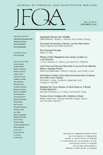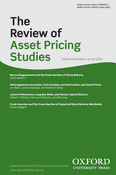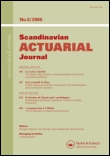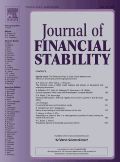
Journal of Risk
Scope & Guideline
Charting New Territories in Risk Analysis
Introduction
Aims and Scopes
- Quantitative Risk Assessment:
The journal focuses on quantitative methods for assessing various types of risks, including market risk, credit risk, and operational risk. This includes the development of statistical models and estimation techniques to measure and manage risk. - Market Dynamics and Financial Stability:
Research often addresses the interplay between market dynamics and systemic risk, exploring how different financial instruments and market conditions impact stability. This includes studies on volatility, liquidity, and the effects of macroeconomic factors. - Investment Strategies and Portfolio Management:
The journal publishes papers that analyze investment strategies, including the optimization of portfolios under various risk scenarios. This encompasses modern portfolio theory, behavioral finance, and the impact of investor sentiment on asset pricing. - Insurance and Risk Transfer:
A significant portion of the journal's publications focuses on risk transfer mechanisms, particularly in the insurance sector. This includes studies on reinsurance strategies, pricing models, and the implications of risk-sharing in financial markets. - Regulatory Frameworks and Risk Management Tools:
The journal engages with the implications of regulatory changes on risk management practices, offering critical assessments of tools such as anti-procyclicality measures and value-at-risk models.
Trending and Emerging
- Advanced Bayesian Estimation Techniques:
There is an increasing focus on Bayesian methods for risk estimation, particularly in portfolio management. This trend highlights the demand for more flexible and robust statistical frameworks that accommodate uncertainty and prior information. - Impact of Climate Change on Financial Risk:
Research examining the implications of climate change for credit and market risk is gaining traction. This emerging theme reflects the growing recognition of environmental factors as critical components of financial risk assessment. - High-Frequency Trading and Market Dynamics:
The analysis of high-frequency trading and its impact on market volatility and risk is becoming more prevalent. This trend underscores the importance of understanding rapid market movements and the associated risks in real-time trading environments. - Risk Management in Cryptocurrencies:
With the rise of cryptocurrencies, there is an emerging focus on assessing risks associated with digital assets. This includes studies on volatility, market behavior, and risk management strategies tailored to this relatively new asset class. - Integration of Machine Learning in Risk Assessment:
The application of machine learning techniques to enhance risk modeling and prediction is on the rise. This trend signifies a move towards leveraging advanced computational methods to improve the accuracy and efficiency of risk assessments.
Declining or Waning
- Traditional Risk Models:
There has been a noticeable reduction in publications focused solely on traditional risk modeling techniques, such as basic value-at-risk calculations without enhancements. This decline may indicate a shift towards more sophisticated, multi-faceted approaches to risk assessment. - General Economic Sentiment Analysis:
Papers that broadly analyze economic sentiment without specific contextual applications have decreased. This suggests a move towards more targeted studies that connect sentiment analysis directly to financial instruments or market events. - Static Risk Assessment Approaches:
Research focusing on static models that do not account for changing market conditions or dynamic systems has waned. The trend now favors dynamic models that incorporate time-varying parameters and real-time data.
Similar Journals

SIAM Journal on Financial Mathematics
Advancing Knowledge at the Intersection of Math and FinanceThe SIAM Journal on Financial Mathematics, published by SIAM PUBLICATIONS, is a premier journal dedicated to the intersection of applied mathematics and finance. With an ISSN of 1945-497X, this journal serves as a vital platform for the dissemination of innovative research that addresses complex financial problems through mathematical modeling and analytical techniques. The journal has established itself within the Q2 quartile in the categories of Applied Mathematics, Finance, and Numerical Analysis, reflecting its influence and significance in these fields. Researchers and practitioners will find a wealth of knowledge spanning topics from stochastic calculus to quantitative finance, making it essential for anyone aiming to advance their understanding of financial mathematics. As the journal continues to converge from 2010 to 2024, it promises to remain a cornerstone resource for academics, professionals, and students alike, facilitating the ongoing dialogue between mathematics and its applications in the financial industry.

International Review of Finance
Bridging theory and practice in global finance.International Review of Finance is a prestigious academic journal published by Wiley, located in the United Kingdom. With its ISSN 1369-412X and E-ISSN 1468-2443, this journal serves as an essential platform for researchers and practitioners in the fields of Economics and Finance. Ranked in the Q2 quartile for both Economics and Econometrics and Finance as of 2023, it showcases high-quality research that contributes significantly to theoretical and practical advancements. Reflecting its standing, the journal is positioned in the 61st percentile in Economics and Econometrics and the 60th percentile in Finance according to Scopus rankings. The scope of the journal includes a diverse range of topics, encouraging innovative discourse across various financial disciplines. Although it does not offer open access, the International Review of Finance continues to be an important resource for academics, professionals, and students seeking to deepen their understanding of evolving financial theories and practices.

JOURNAL OF FINANCIAL AND QUANTITATIVE ANALYSIS
Catalyzing Innovation in Quantitative Financial ResearchJOURNAL OF FINANCIAL AND QUANTITATIVE ANALYSIS, published by Cambridge University Press, is a premier peer-reviewed journal that has been at the forefront of the finance and economics fields since its inception in 1966. With a notable impact factor reflecting its Q1 status in Accounting, Economics and Econometrics, and Finance for 2023, the journal is recognized for its substantial contributions to both theoretical and empirical research. Researchers and practitioners alike benefit from its comprehensive scope, addressing critical issues in financial analysis and quantitative methods. Although the journal does not currently offer open access, it remains widely accessible through institutional subscriptions. The editorial team is committed to fostering rigorous academic discussions that shape the future of finance and economics, making it an essential resource for academics, students, and industry professionals seeking to deepen their understanding of these vital disciplines. For more than five decades, this journal has continued to be an indispensable platform for disseminating influential research, thus solidifying its role as an essential cornerstone in the financial and quantitative analysis community.

MATHEMATICAL FINANCE
Advancing Knowledge in Quantitative FinanceMATHEMATICAL FINANCE is a prestigious journal published by Wiley, focusing on the interdisciplinary fields of finance, applied mathematics, accounting, and economics. With its ISSN 0960-1627 and E-ISSN 1467-9965, this journal has earned its place in the top tier of academic publications, reflected by its Q1 rankings across multiple categories in 2023, including Accounting, Applied Mathematics, Economics and Econometrics, Finance, and Social Sciences. MATHEMATICAL FINANCE, which commenced publishing in 1991, is recognized for its rigorous peer-review process and its significant contribution to the advancement of knowledge in quantitative finance methodologies and risk management practices. Although it does not currently offer open access, the journal remains an invaluable resource for researchers, professionals, and students seeking to stay abreast of the latest theoretical advancements and empirical studies in mathematical finance. Its impact factor and Scopus rankings further illustrate its high standing within the academic community, making it an essential platform for impactful research and scholarly discourse.

Review of Asset Pricing Studies
Connecting Theory and Practice in Asset PricingThe Review of Asset Pricing Studies, published by Oxford University Press, stands as a leading journal in the fields of Economics and Finance, recognized for its rigorous analyses and innovative research since its inception in 2011. This esteemed publication maintains an impressive impact factor and ranks in the Q1 category for both Economics and Finance as of 2023, consistently occupying top positions in Scopus rankings across its relevant categories. With a clear focus on advancing knowledge in asset pricing and investment strategies, the journal serves as a vital platform for researchers, professionals, and students seeking to contribute to and stay informed on the latest developments in these dynamic fields. Despite its lack of open access, the journal ensures wide circulation and accessibility through its reputable publisher, thereby fostering an engaged academic community.

Scandinavian Actuarial Journal
Uncovering transformative insights in economics and statistics.The Scandinavian Actuarial Journal, published by Taylor & Francis Ltd, stands as a pivotal resource in the fields of Economics, Econometrics, Statistics, and Probability, with a legacy dating back to 1918. This esteemed journal, headquartered in the United Kingdom, offers valuable insights and comprehensive research findings that contribute significantly to the actuarial and statistical communities. With its impressive 2023 quartile rankings—Q1 in both Statistics and Probability, and in Statistics, Probability and Uncertainty, as well as Q2 in Economics and Econometrics—this journal is recognized for its high-quality peer-reviewed content, making it indispensable for researchers, professionals, and students alike. Although it currently does not operate under an Open Access model, the journal ensures rigorous academic standards and broad visibility within its field. With a Scopus rank placing it in the top quartile of relevant categories, the Scandinavian Actuarial Journal is committed to advancing knowledge and fostering innovation in statistical methodologies and insights.

Journal of Financial Stability
Pioneering research for resilient financial systems.The Journal of Financial Stability, published by Elsevier Science Inc., is a renowned academic journal that serves as a premier platform for the dissemination of innovative research in the fields of finance, economics, and econometrics. With an ISSN of 1572-3089 and an E-ISSN of 1878-0962, this journal has established itself as a leader in its category, ranking Q1 for both Economics and Finance in the 2023 category quartiles. This positions it amongst the top 13% of journals in Economics and the top 35% in Finance, according to Scopus rankings. Covering a wide range of topics related to financial stability, the journal aims to fulfill its objective of advancing scholarly communication and providing researchers, professionals, and students with valuable insights into contemporary financial challenges and innovations. Operating from the Netherlands and converging from 2004 to 2024, the Journal of Financial Stability continues to contribute significantly to the academic landscape, inviting submissions that push the boundaries of knowledge and understanding in financial systems.

Probability Uncertainty and Quantitative Risk
Navigating the Complexities of Uncertainty with PrecisionProbability Uncertainty and Quantitative Risk, published by the American Institute of Mathematical Sciences (AIMS), is a distinguished open-access journal that has been contributing to the academic community since its inception in 2016. With a focus on the crucial interplay between probability, uncertainty, and quantitative risk assessment, this journal serves as a vital platform for researchers, practitioners, and students engaged in the fields of Applied Mathematics and Statistics. The journal's ranking in the Q2 category for both Applied Mathematics and Statistics and Probability reflects its growing influence and relevance, while its diverse scope encourages interdisciplinary studies. As a part of the Scopus database and maintaining a consistent publication pace through 2024, Probability Uncertainty and Quantitative Risk is essential for anyone looking to remain at the forefront of research in risk analysis and uncertainty modeling. Its commitment to open access since 2016 further enhances accessibility to cutting-edge findings, making it an indispensable resource for academics and industry professionals alike.

Journal of Computational Finance
Unlocking new methodologies for modern financial challenges.Journal of Computational Finance, published by INCISIVE MEDIA, stands at the forefront of interdisciplinary research, amalgamating the realms of finance, applied mathematics, and computer science. With its ISSN 1460-1559 and E-ISSN 1755-2850, this journal provides a vital platform for scholars and practitioners alike, aiming to advance methodologies and computational techniques that enhance financial decision-making processes. Although currently categorized in the Q3 quartile across various disciplines—including Applied Mathematics, Computer Science Applications, and Finance—its commitment to quality research is unwavering, as evidenced by its curated selection of innovative studies. The journal’s scope includes computational modeling, algorithmic trading, risk management, and quantitative finance solutions. Each volume seeks to not only foster academic discourse but also bridge theoretical findings with practical applications in the financial industry. Given its convergence from 2011 to 2024, the journal continues to evolve alongside the rapidly changing financial landscape, supporting researchers, students, and professionals in navigating the complexities of computational finance.

FINANCE AND STOCHASTICS
Charting New Territories in Financial ResearchFinance and Stochastics is a leading academic journal published by Springer Heidelberg, focusing on the intricate interplay of finance, probability, and statistics. With an impressive impact factor and ranked within the Q1 category in both finance and statistics, it serves as an essential resource for researchers and professionals seeking to advance their understanding of stochastic modeling in financial contexts. The journal has maintained a strong reputation since its inception, with contributions from renowned scholars worldwide. The editorial team prioritizes high-quality research that addresses contemporary challenges in financial mathematics and extends the boundaries of statistical methods. Nestled in the heart of Germany, Finance and Stochastics embraces a broad scope, inviting submissions that explore innovative approaches to economic theory and quantitative methodologies. This combination of rigorous academic standards and commitment to impactful research makes the journal a pivotal avenue for disseminating knowledge and fostering collaboration in the finance and statistics communities.